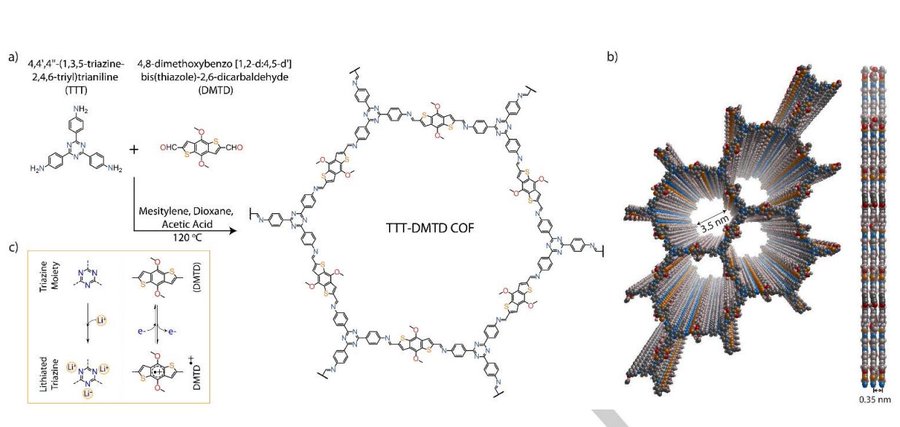Researchers have developed a thiazole-linked covalent organic framework (COF) as a cathode material for lithium-sulfur (Li-S) batteries. The COF, named THZ-DMTD, exhibited high capacity and long-term stability in Li-S batteries.
Facts
- 🔋 Lithium-sulfur (Li-S) batteries offer higher energy density than current lithium-ion batteries.
- 🔬 Covalent organic frameworks (COFs) are used as cathode materials in Li-S batteries.
- 🧪 A thiazole-linked COF called THZ-DMTD was synthesized and demonstrated high capacity and stability.
- ⚡ THZ-DMTD exhibited a capacity of 642 mAh g-1 at 1.0 C and retained 78.9% of its capacity after 200 cycles.
- 🔄 Thiazole linkages were post-synthetically transformed from imine linkages while maintaining the crystallinity of the COF.
- 🔍 The high crystallinity, porosity, and presence of redox-active moieties in THZ-DMTD contributed to its superior performance.
- 📊 THZ-DMTD shows promise as a cathode material for improving the performance and durability of Li-S batteries.
Lithium-sulfur (Li-S) batteries are considered a promising alternative to lithium-ion batteries due to their higher energy density. In these batteries, cathode materials that can host sulfur are crucial. Covalent organic frameworks (COFs) have recently emerged as potential candidates for cathode materials in Li-S batteries. However, stability issues have limited their practical applications. In this study, researchers successfully synthesized a thiazole-linked COF called THZ-DMTD by post-synthetically transforming imine linkages. THZ-DMTD exhibited high crystallinity, porosity, and the presence of redox-active moieties, resulting in its excellent performance as a cathode material. It demonstrated a capacity of 642 mAh g-1 at 1.0 C and retained 78.9% of its capacity after 200 cycles, showcasing its long-term stability. The findings suggest that THZ-DMTD has the potential to enhance the capacity and durability of Li-S batteries, contributing to the advancement of energy storage technologies.
Angewandte International Edition Chemie Title: A Thiazole-linked Covalent Organic Framework for Lithium- Sulphur Batteries A Thiazole-linked Covalent Organic Framework for Lithium- Sulphur Batteries
Yan; Mishra; Traxler; Roeser; Chaoui; Kumbhakar; Schmidt; Li; Thomas; Pachfule; Yan; Mishra; Traxler; Roeser; Chaoui; Kumbhakar; Schmidt; Li; Thomas; Pachfule; Yan; Li; Mishra; Kumbhakar; Pachfule; Li; Traxler; Roeser; Chaoui; Schmidt; Thomas; Pachfule
What this paper is about
- In particular, covalent organic frameworks with ordered uniform channels, robust and tunable architecture and redox-active sites have been considered as promising alternatives.
- Nitrogen-rich materials including porous polymers, carbon nitrides, poly and covalent triazine frameworks have been investigated as electrode materials for batteries, and often exhibited high energy density.
- Subsequently, considering the limited chemical stability of imine COFs, a post-synthetic transformation of the imine-linked COF into a thiazole-linked COF using a bond-locking strategy has been achieved.
What you can learn
- To exploit the promising properties of nitrogen-rich and redoxactive dimethoxybenzo-dithiophene containing materials, triazine-based TTT-DMTD has been synthesized by using a Schiff-base reaction between 4,4,4-trianiline and 4,8-dimethoxy-4,8-dihydrobenzo[1,2b:4,5-b’]dithiophene-2,6-dicarbaldehyde.
- The solvothermal reaction was carried out in the presence of 6 M acetic acid and a mesitylene/dioxane solvent mixture at 120 C in a sealed tube for 3 days.
- The PXRD pattern for TTT-DMTD was found to be dominated by an intense reflection in the low-angle region at 2.40 2 degrees, which can be assigned to the facet of a primitive hexagonal lattice.
- Further, by applying a post-synthetic locking strategy in presence of molecular sulphur, the topochemical conversion of imine-linked TTT-DMTD into a thiazole-linked THZ-DMTD has been achieved.
- Sulphur-assisted chemical conversion of iminelinked COF proved to be offering an efficient way to access robust COF with superior performance, and can be extrapolated to a range of materials for energy storage and other applications.
FAQ
Q: What are lithium-sulfur batteries?
A: Lithium-sulfur batteries are a type of rechargeable battery that use lithium as the positive electrode (cathode) and sulfur as the negative electrode (anode). They are known for their high energy density and have the potential to outperform traditional lithium-ion batteries in terms of capacity.
Q: What is a covalent organic framework (COF)?
A: A covalent organic framework (COF) is a three-dimensional structure composed of organic molecules connected by covalent bonds. It is a porous material with a well-defined structure and has applications in various fields, including energy storage. COFs can be designed and synthesized to have specific properties, such as high surface area and chemical stability.
Q: What is a cathode material?
A: In the context of batteries, a cathode material refers to the component of the battery that acts as the positive electrode during discharge. It is responsible for the reduction reactions that occur during the discharge process. The choice of cathode material is crucial for determining the battery’s performance, including its energy storage capacity and stability.
Q: What is thiazole-linked COF?
A: Thiazole-linked COF refers to a specific type of covalent organic framework where thiazole units are used as building blocks to connect the organic molecules within the framework. Thiazole is a heterocyclic compound containing nitrogen and sulfur atoms. By incorporating thiazole units, the COF can exhibit specific properties and characteristics tailored for certain applications.
Q: What does capacity mean in the context of batteries?
A: Capacity, in the context of batteries, refers to the amount of electrical charge that a battery can store and deliver. It is typically measured in ampere-hours (Ah) or milliampere-hours (mAh) and indicates the total energy the battery can provide during discharge. A higher capacity means the battery can store more charge and potentially provide longer operating times for devices or systems.
Q: What does stability refer to when discussing batteries?
A: Stability, when discussing batteries, refers to the ability of the battery to maintain its performance over time without significant degradation or failure. In the case of lithium-sulfur batteries or any other type, stability refers to their ability to retain their capacity, efficiency, and structural integrity over multiple charge and discharge cycles. High stability is desirable for long-lasting and reliable battery performance.




